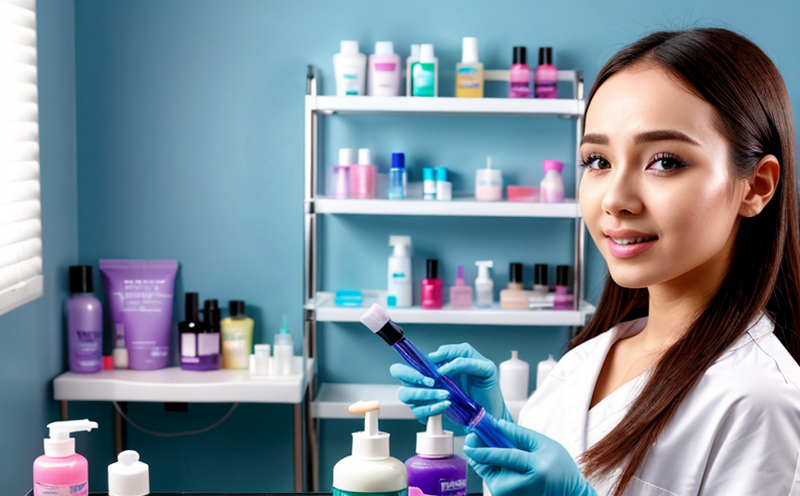ASTM E3206 Contaminant Detection in Cosmetic Microbiology
The ASTM E3206 standard is a critical tool used by laboratories to ensure the microbiological safety of cosmetic products. This test specifically targets the detection and identification of contaminants that may be present in cosmetics, such as bacteria, fungi, yeasts, and other microorganisms that can potentially lead to product spoilage or adverse health effects for consumers.
Contamination is a significant concern in the cosmetic industry due to its direct contact with human skin. The presence of harmful microorganisms can cause irritation, allergic reactions, or even more severe infections. ASTM E3206 provides detailed procedures and acceptance criteria designed to minimize these risks by ensuring that cosmetics meet strict microbiological standards.
The test protocol outlined in ASTM E3206 involves several key steps. First, samples of the cosmetic product are collected from various points within the production facility or directly from finished products. These samples undergo rigorous preparation methods tailored to preserve the integrity and viability of any potential contaminants. The specimens are then inoculated into appropriate culture media designed to support the growth of specific microorganisms.
Following incubation, colonies that appear suspicious for contaminants are isolated and identified using a combination of traditional microbiological techniques such as gram staining, biochemical tests, and modern molecular methods like polymerase chain reaction (PCR). This comprehensive approach ensures accurate detection and identification of even trace amounts of harmful organisms. Once identified, the results are reported according to the requirements specified in ASTM E3206.
For quality managers and compliance officers, understanding the nuances of ASTM E3206 is essential for maintaining high standards within their organizations. By adhering strictly to this protocol, companies can demonstrate their commitment to consumer safety while also complying with international regulations such as those set forth by the European Union's Cosmetics Regulation.
R&D engineers benefit greatly from familiarizing themselves with ASTM E3206 because it provides insights into best practices for minimizing contamination during formulation development. Proper implementation of these guidelines helps prevent costly recalls and enhances brand reputation through consistent product quality.
For procurement teams, ensuring suppliers comply with standards like ASTM E3206 ensures that raw materials used in manufacturing are free from contaminants. This proactive approach reduces the likelihood of introducing unwanted microorganisms into finished products early in the supply chain process.
Why It Matters
The importance of contaminant detection cannot be overstated when it comes to cosmetics and personal care products. Microbial contamination poses significant risks to consumers, ranging from minor skin irritations to severe allergic reactions or infections. Ensuring that all cosmetic products are free from harmful microorganisms is not only a legal requirement but also a moral obligation towards protecting public health.
With increasing awareness about the potential dangers associated with microbial contamination in cosmetics, there has been growing pressure on manufacturers and suppliers to adopt stringent quality control measures. Compliance with standards like ASTM E3206 demonstrates a company's dedication to maintaining high-quality products that meet both regulatory requirements and consumer expectations.
Beyond mere compliance, adhering to such rigorous testing protocols can also offer competitive advantages by fostering trust among customers who value safety and reliability in their purchasing decisions. Companies that consistently produce safe cosmetics are more likely to build strong customer relationships and gain a positive reputation within the industry.
The global nature of the cosmetic market means that manufacturers must consider international standards when designing their quality assurance programs. By integrating ASTM E3206 into their workflows, companies can ensure consistency across different markets while meeting local regulatory expectations.
Quality and Reliability Assurance
The implementation of ASTM E3206 plays a crucial role in enhancing the overall quality and reliability assurance systems within cosmetic manufacturing facilities. This standard provides laboratories with standardized procedures for detecting contaminants, which helps maintain consistent results across different batches or lots of products.
One major benefit of using ASTM E3206 is its ability to identify potential sources of contamination early in the production process. By implementing this test at various stages of manufacturing, companies can pinpoint exactly where issues arise so that corrective actions can be taken promptly. This proactive approach prevents costly recalls and minimizes disruptions to supply chains.
Another advantage lies in the enhanced reliability of the final products produced by adhering strictly to ASTM E3206 guidelines. When every batch undergoes thorough testing according to this protocol, manufacturers have greater confidence that their products will meet or exceed regulatory standards consistently over time. This consistency is vital for maintaining customer satisfaction and trust.
The standard also supports continuous improvement efforts within laboratories by encouraging ongoing training of personnel involved in conducting ASTM E3206 tests. Regular updates on the latest methodologies and best practices ensure that testing remains accurate and up-to-date with current scientific knowledge.
Customer Impact and Satisfaction
The impact of implementing ASTM E3206 extends beyond internal operations; it directly influences customer satisfaction by ensuring product safety and efficacy. When consumers know their purchases are made from companies committed to rigorous quality assurance practices, they feel more secure using these products.
A positive outcome of adhering to this standard is increased consumer trust in the brand. As people become increasingly health-conscious, they place greater emphasis on knowing exactly what goes into their skincare and makeup routines. Companies that go above and beyond regulatory requirements demonstrate a genuine concern for customer well-being, which translates into stronger loyalty and repeat business.
Moreover, compliant products contribute to improved public health outcomes by reducing instances of adverse reactions linked to microbial contamination in cosmetics. This contributes positively towards societal welfare at large, reinforcing the notion that responsible corporate citizenship benefits everyone involved in the industry.





